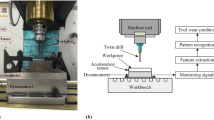Abstract
In the present study, an attempt has been made to predict flank wear during milling operation with the help of signal processing and machine learning techniques. The vibration and acoustic emission signals obtained from the spindle of milling machine with variations in feed and depth of cut are decomposed into various levels using symlet wavelet. To select the best level permutation entropy criteria were applied. Level giving minimum permutation entropy was selected for the calculation of statistical features. Eleven statistical features such as skewness, kurtosis, mean, etc. were extracted from symlet wavelet and feature vector is formed. To select the relevant features, correlation-based feature selection criterion was used for reducing the size of feature vector. Feature vector with vibration signals and acoustic emission signals is fed into machine learning techniques such as linear regression and K-Star to predict the flank wear measured during milling operation. It is observed that K-Star gives higher prediction rate of tool wear with both training and testing of the classifier and feature vector with the reduced feature set with acoustic emission signals gives better prediction accuracy compared to vibration signals.









Similar content being viewed by others
References
Agogino A, Goebel K (2007) BEST lab, UC Berkeley milling data set, NASA Ames prognostics data repository (http://ti.arc.nasa.gov/project/prognostic-data-repository). Accessed Nov 2017
Bhattacharyya P, Sengupta D, Mukhopadhyay S, Chattopadhyay AB (2007) Online tool condition monitoring in face milling using current and power signals. Int J Prod Res 46(4):1187–1201
Drouille C, Karandikar J, Natha C, Journeauxa AC et al (2016) Tool life predictions in milling using spindle power with the neural network technique. J Manuf Process 22:161–168
Fang N, Pai PS, Mosquea S (2011) Effect of tool edge wear on the cutting forces and vibrations in high-speed finish machining of Inconel 718: an experimental study and wavelet transform analysis. Int J Adv Manuf Technol 52:65–77
García Plaza E, Núñez López PJ (2018) Application of the wavelet packet transform to vibration signals for surface roughness monitoring in CNC turning operations. Mech Syst Signal Process 98:902–919
Jemielniak K, Kossakowska J (2010) Tool wear monitoring based on wavelet transform of raw acoustic emission signal. Adv Manuf Sci Technol 34(3):5–17
Jeyakumar S, Marimuthu K, Ramachandran T (2013) Prediction of cutting force, tool wear and surface roughness of Al6061/SiC composite for end milling operations using RSM. J Mech Sci Technol 27(9):2813–2822
Khamel S, Ouelaa N, Bouacha K (2012) Analysis and prediction of tool wear, surface roughness and cutting forces in hard turning with CBN tool. J Mech Sci Technol 26(11):3605–3616
Kuo RJ (2000) Multi-sensor integration for on-line monitoring tool wear estimation through artificial neural networks and fuzzy neural network. Eng Appl Artif Intell 13:249–261
Li X (2002) A brief review: acoustic emission method for tool wear monitoring during turning. Int J Mach Tools Manuf 42(2):157–165
Liang SY, Dornfeld DA (1989) Tool wear detection using time series analysis of acoustic emission. J Eng Ind 111:199–205
Madhusudana CK, Kumar H, Narendranath S (2016) Condition monitoring of face milling tool using K-star algorithm and histogram features of vibration signal. Eng Sci Technol Int J 19(3):1543–1551
Mishra SK, Rao US, Kumar S (2016) Tool wear prediction by using wavelet transform. Int J Precis Technol 6(3/4):216–230. https://doi.org/10.1504/ijptech.2016.080000
Niu YM, Wong YS, Hong GS (1998) An intelligent sensor system approach for reliable tool flank wear recognition. Int J Adv Manuf Technol 14(2):77–84
Ramalingam VV, Mohan S (2016) Prosthetic arm control with statistical features of EEG signals using K-star algorithm. J Appl Sci 16:138–145
Sivasakthivel PS, Sudhakaran R, Rajeswari S (2017) Optimization and sensitivity analysis of geometrical and process parameters to reduce vibration during end milling process. Mach Sci Technol 21(3):452–473
Vakharia V, Gupta VK, Kankar PK (2015) Ball bearing fault diagnosis using supervised and unsupervised machine learning methods. Int J Acoust Vib 20:244–250
Vakharia V, Gupta VK, Kankar PK (2016a) A comparison of feature ranking techniques for fault diagnosis of ball bearing. Soft Comput 20(4):1601–1619
Vakharia V, Gupta VK, Kankar PK (2016b) Bearing fault diagnosis using feature ranking methods and fault identification algorithms. Procedia Eng 144:343–350
Vakharia V, Gupta VK, Kankar PK (2017) Efficient fault diagnosis of ball bearing using ReliefF and Random Forest classifier. J Braz Soc Mech Sci Eng 39(8):2969–2982
Wang M, Wang J (2012) HMM for tool condition monitoring and remaining useful life prediction. Int J Adv Manuf Technol 59:463–471
Wang F, Liu J, Shu Q (2017) Milling wear of carbide tool for processing nickel-based alloy in cryogenic based on the entropy change. Int J Adv Manuf Technol 90(5–8):1703–1713
Acknowledgement
The authors are thankful for Kai Goebel (NASA Ames) and Alice Agogino (UC Berkeley) for providing permission to use milling dataset for research purpose.
The authors are thankful to the Editor and anonymous reviewers of Journal of Life Cycle Reliability and Safety Engineering for providing opportunity to publish journal paper. The authors would like to acknowledge the support of PDPU, Gandhinagar for providing the infrastructure required for carrying out the study.
Author information
Authors and Affiliations
Corresponding author
Rights and permissions
About this article
Cite this article
Vakharia, V., Pandya, S. & Patel, P. Tool wear rate prediction using discrete wavelet transform and K-Star algorithm. Life Cycle Reliab Saf Eng 7, 115–125 (2018). https://doi.org/10.1007/s41872-018-0057-5
Received:
Accepted:
Published:
Issue Date:
DOI: https://doi.org/10.1007/s41872-018-0057-5




